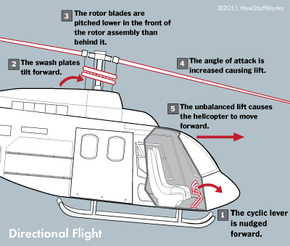Flying a Helicopter: Directional Flight
In addition to moving up and down, helicopters can fly forward, backward and sideways. This kind of directional flight is achieved by tilting the swash plate assembly with the cyclic, which alters the pitch of each blade as it rotates. As a result, every blade produces maximum lift at a particular point. The rotor still generates lift, but it also creates thrust in the direction that the swash plate assembly is tilted. This causes the helicopter to lean — and fly — in a certain direction. The pilot can impart additional directional control by depressing or easing up on the foot pedals, which increases or decreases the counteracting thrust of the tail rotor.
Let's assume for a moment that the helicopter we discussed in the last section needs to fly forward. This is the pilot's procedure:
Advertisement
- First, he or she nudges the cyclic lever forward.
- That input is transmitted to the lower swash plate and then to the upper swash plate.
- The swash plates tilt forward at an amount equal to the input.
- The rotor blades are pitched lower in the front of the rotor assembly than behind it.
- This increases the angle of attack — and creates lift — at the back of the helicopter.
- The unbalanced lift causes the helicopter to tip forward and move in that direction.
When the aircraft reaches about 15 to 20 knots of forward airspeed, it begins to transition from hovering flight to full forward flight. At this point, known as effective translational lift, or ETL, the pilot eases up on the left foot pedal and moves closer to a neutral setting. He or she also feels a shudder in the rotor system as the helicopter begins to fly out of rotor wash (the turbulence created by a helicopter's rotor) and into clean air. In response, the rotor will try to lift up and slow the aircraft automatically. To compensate, the pilot will continue to push the cyclic forward to keep the helicopter flying in that direction with increasing airspeed.
A helicopter that is flying forward can stop in midair and begin hovering very quickly. We'll cover this signature maneuver next.
